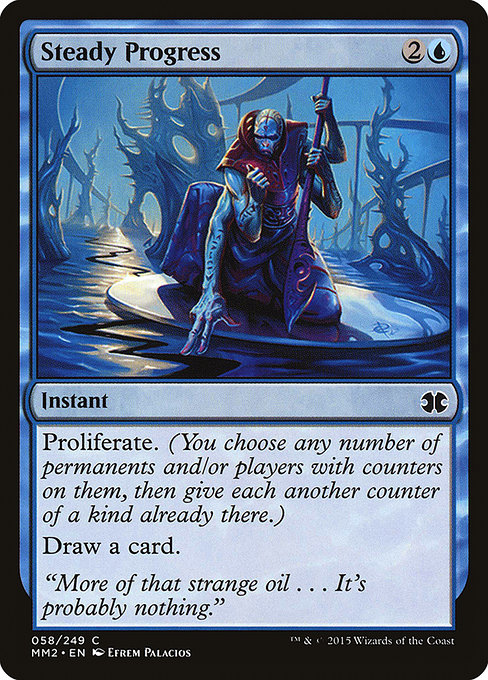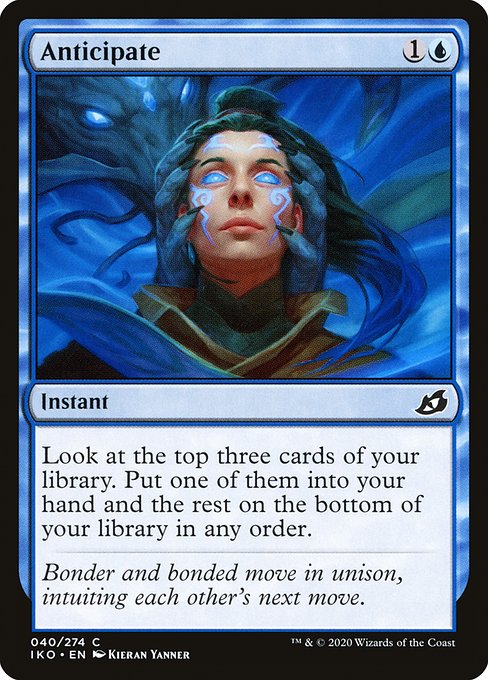Phyrexia: All Will Be One Limited may be a bit fast and linear for my tastes, but it’s also chock full of notable designs that can teach volumes about game design in general, Magic’s latest mechanical developments, and the construction of this particular format. For today, let’s look at a powerful common in a less-than-powerful color with a mixed-powered pedigree. Let’s talk about Experimental Augury.

At first blush, Experimental Augury is an exciting card. It’s an instant-speed cantrip with selection with the potential to generate loads of additional value. In practice, that’s hard to achieve in ONE Limited. Phyrexia: All Will Be One is a fast format defined by curving out with linear synergistic aggro decks. Many games are defined by either playing lots of early creatures or stumbling and losing, so there’s rarely a good window to cast Experimental Augury without falling behind. Moreover, Experimental Augury works best later in the game when you’ve got loads of oil to Proliferate, but many games simply don’t last that long or don’t hinge on a single Proliferate. Plus, if you’ve already got a board full of oily creatures and aren’t in danger of immediately losing, you’re probably already winning and Experimental Augury is just a win-more card. However, this is all contextual—put Experimental Augury in a different format and everything changes. If we look back into the past, it’s clear that Experimental Augury is much more powerful than its ancestors despite being weaker than them in its particular format.

What is the value of single Proliferate?
Proliferate has shown up at volume in three sets across thirteen years. Each time has given insight into how Wizards perceived the value and cost of Proliferating.
Proliferate was introduced in 2010’s Scars of Mirrodin. There, Wizards was being careful with the new mechanic, especially in the context of an artifact set (which always caused balance issues up until Magic committed to regularly using colored artifacts in 2019). Here, Proliferate was treated as worth about one mana. Steady Progress costs three, which is one mana for Proliferating plus the two usually added when an effect draws a card. The costing proved a bit cautious, but it makes sense within the context of Scars block. The block had poison and -1/-1 counters, both of which were granted by its many Infect creatures. This meant that Proliferate could often shrink or kill a creature while incidentally ticking up your opponent’s poison, so it’s an especially powerful effect to be able to deploy at instant speed during combat. Moreover, Proliferate wasn’t a major feature mechanic, appearing only on 14 cards (only 5 of which were common) across all three sets of Scars of Mirrodin block. But this cautious first foray was not the last word on Proliferate.

Jump forward almost a decade to 2019’s War of the Spark, and Proliferate is at its most valuable. In Scars of Mirrodin, you could diminish an opposing threat or tick up poison (a number that generally didn’t matter until it got very high). In WAR, you could Proliferate +1/+1 counters and Planeswalker loyalty counters. Instead of reacting to what your opponent had going on, you were proactive and aspirational, building up threats and eking additional value of Planeswalkers like Narset, Parter of Veils that can’t gain loyalty on their own. Proliferate was both easier to use and generated more powerful resources than it did in Scars of Mirrodin.
Despite Proliferate’s greater potential, its cost mostly stayed the same or went down. Graceful Apparition was a colorshifted Thrummingbird. Wanderer’s Strike was basically a colorshifted Spread the Sickness. Contentious Plan dropped a whole mana from Steady Progress. Usually, that’s a fair trade for slowing an instant into a sorcery, but when much of the value Proliferation provides is bonus loyalty for your Planeswalkers’ sorcery-speed loyalty abilities, it’s more of an upgrade than a sidegrade. So in spite of WAR’s context providing a strong argument for Proliferate needing to be weakened in the format, its cost staying about the same cost suggests that it probably could have been cheaper in Scars of Mirrodin.
Proliferate was also a far more prominent mechanic in War of the Spark, appearing on 15 cards (8 of which were common), a higher density in one set than there was across all of Scars of Mirrodin block. With a bigger spotlight and a decade’s worth of experience, Wizards confidently decided to keep Proliferate worth about one mana, though Contentious Plan suggested it could be even cheaper.

In 2023’s All Will Be One, Proliferate is at a higher volume and lower cost than ever. It shows up on 31 cards (13 of which are common). On most designs, it’s free value on top of already acceptable effects (with room for a little extra value) like Experimental Augury (Anticipate),Mesmerizing Dose (Claustrophobia) or a free bonus option on cards like Adaptive Sporesinger, Contagious Vorrac, and Thirsting Roots. The cost has dropped from about a full mana to something like a third or a quarter of a mana. And yet Proliferate is almost certainly less powerful than it was in SOM and WAR. We’ve gotten to half of the reason already—a fast format like ONE often doesn’t give you time to build up a board and then eke out value by Proliferating onto it, while a slower format like WAR gives you breathing room. The second reason Proliferation is weaker in ONE is what you’re Proliferating.
Ticking poison up by one is a little bit better in ONE than it was in SOM thanks to Corrupted, but it’s also undermined by Toxic. In Scars, poison decks were all-in; while Infecting your opponent, you ignored their life total. If the poison plan failed, you had to start chipping away from 20 life. This meant Proliferate could be an essential piece in getting over the finish line. In All Will Be One, Toxic creatures inflict both damage and poison, meaning that it’s facile to pivot to a damage kill if poison is going to fall short. This reduces the value of Proliferation. Secondly, there’s oil. Oil counters sometimes function as +1/+1 counters, but most of the time, they’re more akin to charge counters and are far less valuable. Getting an extra charge out of your Axiom Engraver, Gitaxian Raptor, or Lattice-Blade Mantis is nice, but not as valuable as a +1/+1 counter on that creature, loyalty counter on a Planeswalker, or a -1/-1 counter on an opponent’s creature.
Putting everything together, what does Proliferate cost? While it’s substantially cheaper in ONE than it was in WAR or SOM, that might be more a reflection of how much weaker it is in this one context than an outright statement about Proliferate’s appropriate cost in all formats. For all we know, Experimental Augury might be too powerful for the next format in which Proliferate appears, since it’s a freebie on top of Anticipate. So, I can’t confidently say whether Proliferate should be worth a small fraction of a mana as it is in ONE, a full mana mana as it was in WAR and SOM, or somewhere in between like half a mana. We’ll just have to wait until next time.

Squeezing value out of Anticipate
There are two parts to Experimental Augury. We’ve spent the vast majority of this article exploring what it says about Proliferate more broadly, but there’s also the card that constitutes the majority of its mana cost, Anticipate. And, well, we’ve already done Design of a Card: Anticipate, so we’ll skip right past that. The one big thing that’s changed is actual Impulse has returned to Standard in Dominaria United and proved totally acceptable. So Anticipate now clearly has room to squeeze in a bit of extra value, just like Cancel and Shock do. And who knows, maybe the next Experimental Augury we see will be an Impulse variant. And whether it’ll be at two mana (with the Proliferate free) or three mana (with the Proliferate adding a cost or because Impulse simply does not have room for any extra value) will give us more insight into both the mechanic and the style of card.
And with that, we’ll close the chapter on Anticipate and starting looking to the future. In a couple hours from now, Lord of the Rings will get its first big spoiler, and in two more days, March of the Machine story begins. And I’m happy to say, I’m looking forward to both. But until then, and as always, thanks for reading.
Zachary Barash (he/him) is a New York City-based game designer and the last commissioner of Team Draft League. He designs for Kingdom Death: Monster, has a Game Design MFA from the NYU Game Center, and does freelance game design. When the stars align, he streams Magic (but the stars align way less often than he’d like).

